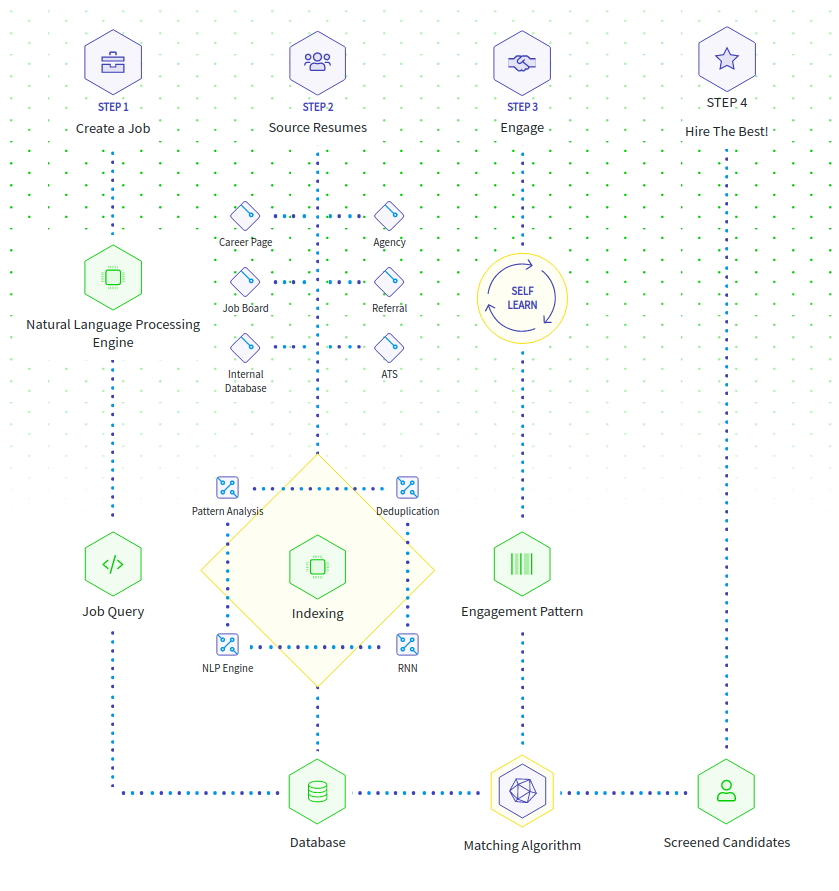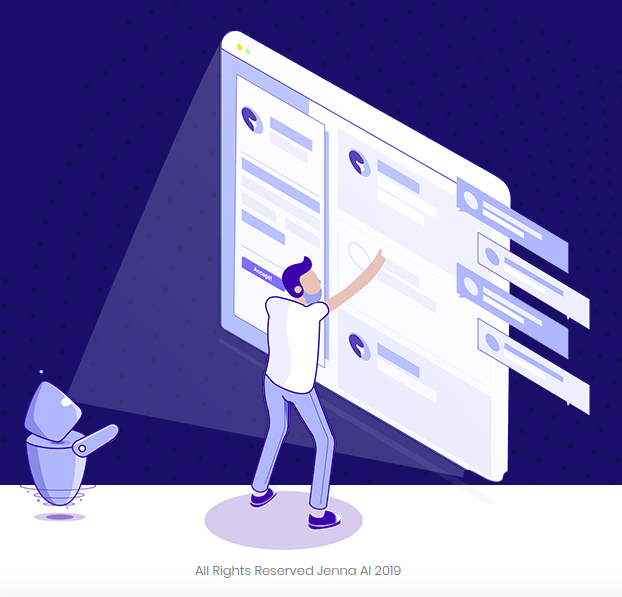How new technology is disrupting HR in 2020
Human Resources (HR) is rapidly changing because of culture, work types, business structures, and technology. Workload in HR teams is increasing with staff mobility and increasing quit-rates. And low unemployment rates are making it harder to acquire talent.
As competitors use the latest tools, you’re more at risk of your preferred candidate already accepting another position with a faster-moving organisation. People trained in HR more than ten years ago will have either upgraded their skills or will be failing to take advantage of the new opportunities. We’ve provided this industry roundup to clarify what is happening now, and get you pointed in the right direction.
HR is currently buzzing with stories about robotic process automation (RPA), machine learning (ML), and artificial intelligence (AI). So let’s start with a clear understanding of these terms.
Robotic Process Automation
Long before AI came onto the scene RPA had started eating away at the repetitive tasks done in HR. Don’t let the word ‘robotic’ distract you, its use here is closer to the source meaning ‘forced worker’ than the mechanical men of Hollywood. Advanced RPA systems can seem almost human in what they do, but under the hood, they’re basically an if-this-happens-then-do-that system.
They increase efficiency, reduce drudgery, and don’t make typos or other errors. If you ever find yourself repeating the same steps, based on rules you could write down, responding only to information that is or could be in a computer, you should use RPA to do it for you.
Machine Learning
If AI were a toaster, then ML would be those orange glowing wires that do the work. It is at the heart of AI, and is what gives it those almost-magical powers. You don’t need to understand how it works, but knowing what it does will put you in a strong position to decide when it can help you. So bear with me for a moment.
To do human-like tasks which are complex and hard to define, computers have to be trained rather than programmed. This requires a lot of data, and that data needs to be paired as ‘when it looks like this’—’we call it that’. What makes it so powerful is the examples in the data can be very complex. Like styles of artwork, or resumes. Each resume in the training data set needs its ‘we call it that’ data connected to it, like ‘good worker’ or ‘unreliable worker’.
Unfortunately the set of training data needs to be huge. So if you don’t have thousands of resumes for both good and bad workers, you won’t be able to use ML to train your AI. The smaller that set of data, the more likely your ML process will mistake correlation for cause. We know that workers with even-numbered ages are not better than odd-numbered ages. But machines don’t, and could make this false correlation using a small data set. Because we never know what’s going on inside ML processes, these mistakes result in false biases that we don’t know about.
Artificial Intelligence
The term AI is misleading. It would be better to call it artificial pattern recognition. Arguably human intelligence could also be called ‘making the appropriate response to everything we experience by recognising the patterns’. But AI only recognises very specific sets of patterns that they’ve been trained on. It is a rapidly developing technology, and the term includes the field, the systems being used, and the package that gets rolled out to customers. It relies on ML to do its work though, and can’t do anything that ML can’t achieve.
It is also misused, both by accident and on purpose, because it works really well in marketing. Like blockchain was in 2017, AI is the snake oil of 2020, so buyers beware. When evaluating whether an AI claim is genuine think of the ML that’s driving it and ask, what could they be using for training data, and how are they choosing the ‘we call it that’ information for each example?
Where robotic process automation and AI are used in HR
From now on, we’ll only be talking about RPA and AI, knowing that ML is supporting it. This technology is changing incredibly fast. And new players that offer software and services are pouring into the market faster than industry experts can keep up. It’s not possible to create an exhaustive list of what’s available, but websites like Capterra and G2 try to stay on top of things.
And it’s not just the new kids on the bloc that are adopting RPA and AI technologies. The old established players are also incorporating this technology into their platforms. It’s certainly not just HR that’s being disrupted, so broader software suites might also meet your needs, all the way up to Enterprise Resource Planning systems.

Applicant tracking systems (ATS) work across many of the areas we cover below, so they’re worth a special mention here. While components of them might use AI, their basic function should not. The information that is used in an ATS is well structured, like who the applicant is, the position they’re applying for, and where they are in the process. RPA is incredibly useful with this sort of structured information. But AI’s powerful pattern recognition abilities are not required. So if software implies that it uses AI to do this, be wary, that might be snake oil you’re smelling.
Candidate Screening: Cast a wider net with less effort
Attracting talent
One area where AI has recently become competent is writing text based on a short prompt. GPT2 is an AI model that is so good at writing fluent English that it caused a stir when Open AI, the creators, chose not to release it to the public over fear of misuse. Since then, this area of AI usage has leaped ahead, and now trained AI models can write job advertisements for you based on the skills required.

During periods of low unemployment, or when trying to attract the top talent, it is not enough to target active candidates who are looking for work. Passive candidates who are already satisfactorily employed must also be drawn into the application process. This is where chatbots really shine. Also using AI for strong language skills, chatbots incorporate the ability to keep track of information that has been gathered and then craft questions to fill in the blanks. In this way, a casual visitor might be organically drawn into a job application process. Chatbots can even schedule interviews.
Resume Process
It’s a shame that sometimes the best candidate doesn’t even get a look-in because too many resumes had already arrived before theirs could be added to the pile. But with limited time and staff resources, it is impossible to look through an unlimited number of resumes to see if it is suitable.

It’s important here to clarify the difference between a suitable resume, and a suitable candidate. AI systems can do useful things like converting university names, qualifications, business names, and dates from a resume into data files. They can’t yet pick up on the tone of voice and determine if the candidate is a good fit for the company culture. But that’s okay. By weeding out the vast majority of unsuitable applicants, and then ranking the remainder, human skills can be reserved for the ones that are worth the effort. This means that instead of capping the number of resumes accepted, you can turn the tables and include previous resumes as well as sorting through resumes in online databases.

AI can also crawl through online data sources like social media platforms and background-checking services to ensure your time won’t be wasted by applicants who would eventually be revealed as unsuitable, or even damaging, to your organisation.
Interviewing: don´t overlook the best candidates
The amount of time it requires to interview each applicant can also result in the best candidate being overlooked, as well as being a huge drain on the HR team’s resources. Automation and AI can take away the burden of at least the initial interview process.

These include,
- determining which candidates to interview,
- arranging the appointment,
- conducting an online video interview,
- reviewing the responses,
- analysing facial expressions,
- and even generating transcripts.
The results of these interviews can add data about the applicant and move them forward or remove them from the Applicant Tracking System process.
Onboarding: An easy path to success
RPA and AI do more in the recruitment process than finding your best candidate, they also give the candidate a better experience during the process by automating communication that keeps in touch as they progress towards employment. But this is only the beginning of establishing a productive workforce. The onboarding experience, and the information that it provides has a measurable impact on future performance.

And because onboarding processes can be very repetitive, they’re perfectly suited to RPA. Again—AI driven chatbots can be used here to provide quick answers and access to information.
Career Development: Hang onto talent with a career path
Once the new employee has settled into their position, a whole new journey begins. Tata, one of India’s largest conglomerates, is implementing a system that analyses employee skills and their preferred career path to generate a training plan to get them to where they want to be.
And with all of this increase in recruitment technology, including tools for targeting passive candidates, it’s becoming increasingly important to measure and manage job satisfaction. It might seem incredible, but the global IT company IBM is able to use AI to predict employee flight risk with 95% accuracy.
Removing Bias: From machine and human processes
While there are often stories of how AI can be biased, both generally and during the hiring process, it is important to remember that in most cases this bias was learned through the training data that was based on current human processes. It is also worth understanding how AI can reduce bias in the hiring process by hiding things like the age, gender, and ethnicity of applicants. This is achieved by recognising and removing indicators from all of their data, like the names of schools that accept students based on gender, or replacing names that correlate with ethnicities. Removing irrelevant information before humans get to see it, removes the opportunity for bias, and makes it easy to prove it didn’t influence decisions.
Benefits
Using the most current and powerful recruitment technology does more than quickly and efficiently employ the best candidates from a wider pool. It enables you to provide them with a great experience through employment and beyond.
It all boils down to retaining the best talent at the lowest cost-per-hire.










